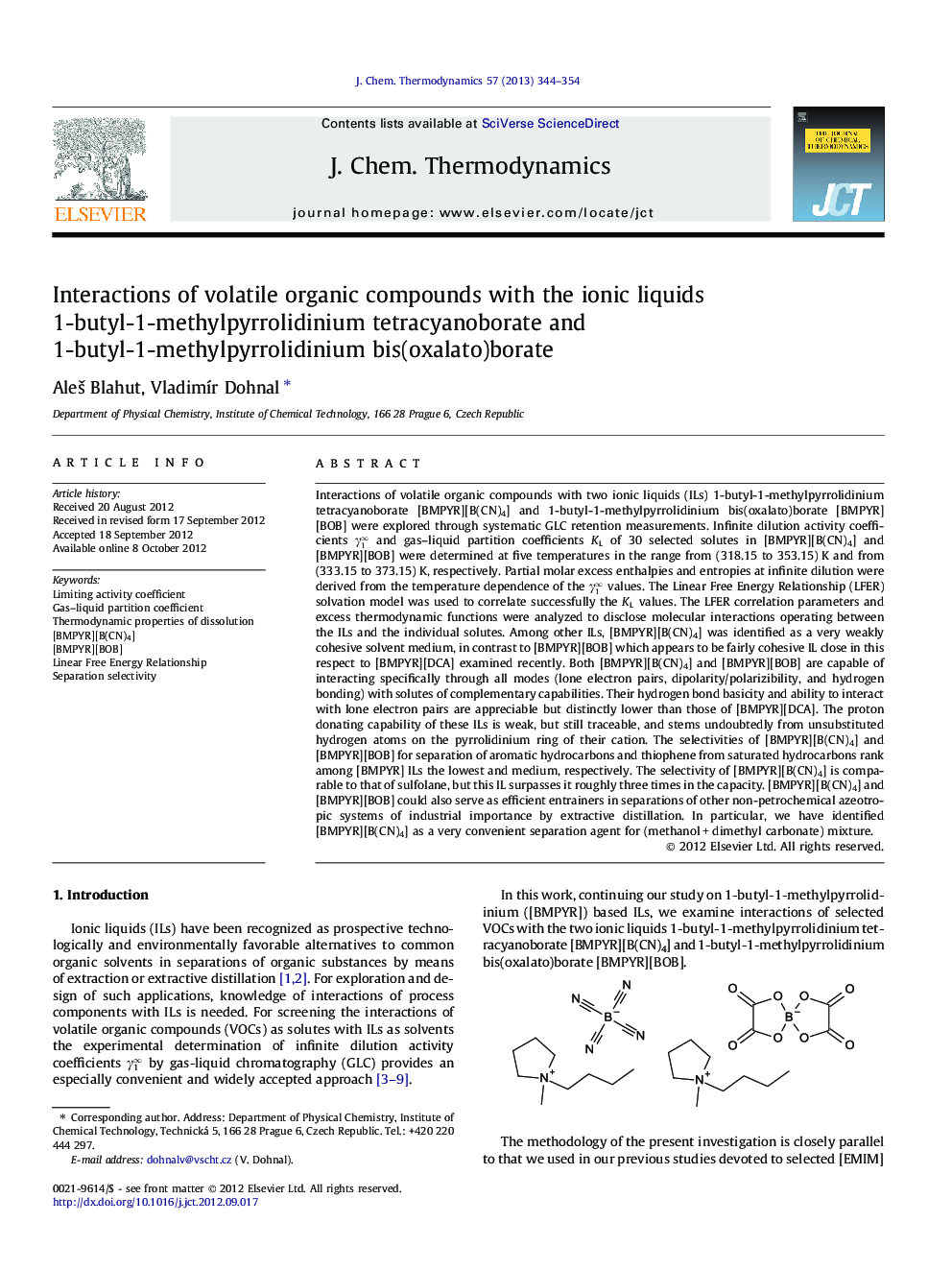| کد مقاله | کد نشریه | سال انتشار | مقاله انگلیسی | نسخه تمام متن |
|---|---|---|---|---|
| 215770 | 1426256 | 2013 | 11 صفحه PDF | دانلود رایگان |

Interactions of volatile organic compounds with two ionic liquids (ILs) 1-butyl-1-methylpyrrolidinium tetracyanoborate [BMPYR][B(CN)4] and 1-butyl-1-methylpyrrolidinium bis(oxalato)borate [BMPYR][BOB] were explored through systematic GLC retention measurements. Infinite dilution activity coefficients γ1∞ and gas–liquid partition coefficients KLKL of 30 selected solutes in [BMPYR][B(CN)4] and [BMPYR][BOB] were determined at five temperatures in the range from (318.15 to 353.15) K and from (333.15 to 373.15) K, respectively. Partial molar excess enthalpies and entropies at infinite dilution were derived from the temperature dependence of the γ1∞ values. The Linear Free Energy Relationship (LFER) solvation model was used to correlate successfully the KLKL values. The LFER correlation parameters and excess thermodynamic functions were analyzed to disclose molecular interactions operating between the ILs and the individual solutes. Among other ILs, [BMPYR][B(CN)4] was identified as a very weakly cohesive solvent medium, in contrast to [BMPYR][BOB] which appears to be fairly cohesive IL close in this respect to [BMPYR][DCA] examined recently. Both [BMPYR][B(CN)4] and [BMPYR][BOB] are capable of interacting specifically through all modes (lone electron pairs, dipolarity/polarizibility, and hydrogen bonding) with solutes of complementary capabilities. Their hydrogen bond basicity and ability to interact with lone electron pairs are appreciable but distinctly lower than those of [BMPYR][DCA]. The proton donating capability of these ILs is weak, but still traceable, and stems undoubtedly from unsubstituted hydrogen atoms on the pyrrolidinium ring of their cation. The selectivities of [BMPYR][B(CN)4] and [BMPYR][BOB] for separation of aromatic hydrocarbons and thiophene from saturated hydrocarbons rank among [BMPYR] ILs the lowest and medium, respectively. The selectivity of [BMPYR][B(CN)4] is comparable to that of sulfolane, but this IL surpasses it roughly three times in the capacity. [BMPYR][B(CN)4] and [BMPYR][BOB] could also serve as efficient entrainers in separations of other non-petrochemical azeotropic systems of industrial importance by extractive distillation. In particular, we have identified [BMPYR][B(CN)4] as a very convenient separation agent for (methanol + dimethyl carbonate) mixture.
► Limiting activity coefficients for 30 VOCs were determined.
► Solution thermodynamic quantities were derived and analyzed.
► [BMPYR][B(CN)4] is an IL of a very low cohesivity.
► [BMPYR][BOB] exhibits higher selectivities for petrochemical separations.
► [BMPYR][B(CN)4] separates the azeotropic mixture (methanol + dimethyl carbonate).
Journal: The Journal of Chemical Thermodynamics - Volume 57, February 2013, Pages 344–354